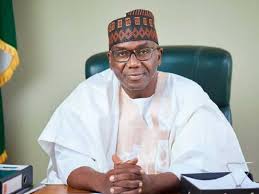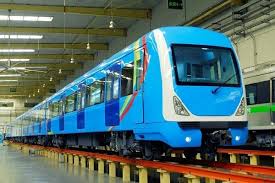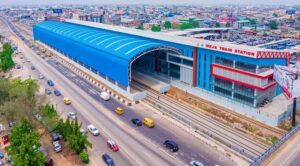
Transport review 2022: Rail performed below expectation as Maritime sector experienced massive growth
The year 2022 was mixed year for stakeholders in the Maritime industry and Rail sector, as the Maritime sector experience massive investment but didn’t meet up with expectations in terms of cargo clearance, gridlock among others despite huge investment by Federal Government, why the rail sector suffers set back in the country. Seun Ibiyemi takes a look at major events that shape both sector in 2022.
Like every other year, lack of enforcement of maritime related policies posed a huge setback for the nation’s maritime sector, in addition to myriads of other factors ranging from poor seaport access roads, lack of holding bays and quay, inadequate truck parks, and ineffective traffic management around the ports, especially within the country’s two busiest ports in Lagos.
For instance, stakeholders expected the port to be fully automated, the deployment of deep blue project expected to put an end to maritime crimes and piracy in the nation’s coastal water and Gulf of Guinea (GoG), among others.
But, while the electronic call-up system solved the crisis of the traffic gridlock on the port access road, other things, such as container deposit, shipping surcharge, Lagos -Onitsha barging initiative of the National Inland Waterways Authority (NIWA), among others, are still begging for closer attention.
Development that shaped the maritime sector
$1.5 billion Lekki deep seaport: It is the largest seaport of Nigeria and one of the biggest in West Africa. Lekki port is to be expanded to have a capacity of handling around 6 million TEUs of containers and a significant volume of liquid and dry bulk uncontainerized cargoes. The port is to be equipped with ships able to transport over 14,500 containers.
The port is being developed in phases. Its phase one, be operational in 2018, chiefly comprises it three container berths equipped to handle more than 1.8 million TEUs — one berth for dry bulk goods and two berths for liquid cargo.
The port is financed by private investors and a consortium of banks who have funded the project with $1.5 billion as of March 2021. The seaport is to occupy up to 90 hectares of land. It is expected to be completed in 2023 and operations to commence in the first half.
On October, 31st, 2022, the port has been handed over to the owners. Commissioning will start “in the next month”.
Lagos State Governor Sanwo-Olu promised on this occasion to expand the roads to the port to 6 lane highways.
$2.5bn Badagry Deep Seaport:
The Buhari Administration has approved the development of the Badagry Deep Sea Port which, upon completion, would have about 2.5km quay length container terminal, 0.5km quay length break bulk terminal, 360m quay length OSB terminal and minimum of 18m draught. It is also expected to generate 250,000 direct jobs.”
The Deep Sea Port is part of an FTZ area seated on approximately 1,104 hectares of land, the FTZ comprises of the Port Zone, Logistics Zone, Industrial Zone, and a Power Hub. The port upon completion will generate over $53 billion within the concession period.”
NIMASA capacity building
The Nigerian Maritime Administration and Safety Agency NIMASA sent forth 235 Nigerians to India and Greece as batch B of the 435 young Nigerians to be trained as Licenced Deck and Engine Officers including Naval Architects under the Nigerian Seafarers Development Programme, NSDP
IMO Secretary General visit
The Secretary General of the International Maritime Organisation, His Excellency Kitack Lim, visited the Federal Republic of Nigeria between November 20th – 22nd 2022.
He declared Nigeria as a very important country not only to Africa, but to the global economy. He stated this on arrival in the country at the meet and greet reception hosted in his honor by stakeholders in the Nigerian maritime industry.
The Secretary General of the International Maritime Organisation (IMO), Mr. Kitack Lim also commissioned the ultra-modern headquarters of the Nigerian Maritime Administration and Safety Agency (NIMASA), located at Victoria Island, Lagos.
Maritime Security (deployment of Deep Blue Project)
After Federal Government launched in June of 2021 its maritime security assets under the Integrated National Security and Waterways Protection Infrastructure, also known as the Deep Blue Project.
In 2022 to boost the deep blue project, the Federal Government of Nigeria has signed a $2.78 million exchange of note agreement with the Japanese Government for an economic and social development programme.
NIMASA takes delivery of additional mobile assets for enhanced maritime security under its deep blue project.
Two unmanned aircraft system, nine interceptor patrol boats and 10 armoured vehicles have been added to the existing assets earlier procured by the Federal Government and commissioned by President Muhammadu Buhari.
The Project, which was initiated by the Federal Ministry of Transportation and Federal Ministry of Defence, is being implemented by the Nigerian Maritime Administration and Safety Agency (NIMASA).
The main objective of the Deep Blue Project is to secure Nigerian waters up to the Gulf of Guinea (GoG). The Project has three categories of platforms to tackle maritime security on land, sea, and air.
The land assets include the Command, Control, Communication, Computer, and Intelligence Centre (C4i) for intelligence gathering and data collection; 16 armoured vehicles for coastal patrol; and 600 specially trained troops for interdiction, known as Maritime Security Unit.
The sea assets include two Special Mission Vessels and 17 Fast Interceptor Boats. The air assets comprise two Special Mission Aircraft for surveillance of the country’s Exclusive Economic Zone (EEZ); three Special Mission Helicopters for search and rescue operations; and four Unmanned Aerial Vehicles.
The Deep Blue Project is the first integrated maritime security strategy in West and Central Africa with the aim of tackling the cases of piracy, sea robbery, and other crimes at sea.
With the official launch of the Deep Blue project in June (though it had been operational since February 2021), the International Maritime Bureau (IMB) in October said incidents of piracy in the first nine months of 2021 in the GoG are the lowest reported in 17 years.
The latest report from the IMB showed that the Gulf of Guinea region recorded 28 incidents of piracy and armed robbery in the first nine months of 2021, compared to 46 at the same period in 2020.
The report noted that: “Nigeria reported only four, compared to 17 in 2020 and 41 in 2018. Crew kidnappings in the region dropped with a single crew member kidnapped in quarter three of 2021, compared to 31 in five separate incidents during the same quarter in the preceding year.”
X-raying Bello Koko’s Transformation of NPA
Plugging of revenue leakages
Since appointment as substantive Managing Director/ CEO in February 2022, Mohammed Bello Koko has recorded several milestone achievements that has earned accolades and awards from several media organisation. Nigeria today is battling revenue challenges due to unprecedented oil theft.
The NPA under Koko has in the last 10 months remitted billions of Naira to the federation account, helping the Federal Government to mitigate the revenue challenge.
He did this by tightening the collection mechanisms and plugging of revenue leakages that resulted in the unprecedented generation of the sum of N286 billion and the remittance of N103 billion as at October 2022 to the Consolidated Revenue Fund (CRF) of the federation.
Building decaying port infrastructure has always been Koko’s dream, and he has done so with the Provision and installation of 86 number Buoys for Warri and Calabar Pilotage Districts.
Other stellar achievements include; survey and Installation of Buoys at Ijegun/Kirikiri water channel, licensing and Upgrading of Pilots across the four Pilotage District, acquisition of Harbour Crafts (Tugboats, Pilot Cutters, and Patrol Boats, licensing of additional four truck parks to increase capacity of truck parks servicing the Lagos Ports and licensing of 10 Export Processing Terminals to facilitate exports at Nigerian Sea Ports. Four of these terminals are already fully operational.
Truck turn-around
Anyone who has been to Apapa in recent years will testify to the menace of truckers and the resulting gridlock on port access roads. Today, there is significant reduction in truck turn-around time due to successful monitoring of the E-Call Up System. To minimize breakdown of trucks on port access roads, about 3,000 trucks have been inspected, certified and issued stickers to ensure safety and compliance with ISO certification requirements and Minimum Safety Standards (MSS).
This lead to 65 per cent reduction in number of accidents recorded, arising from improved standard of trucks operating within the Port premises. The NPA, following Koko’s directive has enforced full compliance of trucks to E-Call Up regime and Minimum Safety Standard resulting in significant reduction in the traffic gridlock along the main Port corridor and the internal access roads through enforcements, proper batching, continuous access control mechanisms and movement of cargo via barge operations.
Achievements galore
With vital things necessary for effective port operation lacking, what the NPA has achieved in the last 10 months is unprecedented.
They include; the survey and Mapping of the FairWay Buoy up to Warri-Sapele-Koko Ports to the prescribed standards of the UKHO Charts, increase Container holding capacity at Rivers Port arising from conversion of unused space within PTOL Terminal into stacking area, provision of 24 motor cycles deployed to aid effective monitoring of Truck E-Call Up operation at Apapa/TCIPC/Ijora axis to ease free flow of traffic, signing of Memorandum of Understanding (MoU) with the National Bureau of Statistics (NBS) for data digitalization and exchange for effective integration of Ports statistics with National Database and upgrading of Website and Daily Shipping Position Portal. Others are the upgrade of infrastructure at Terminal ‘B’, Berth 7 and 8, Onne Port Complex based on Messrs WACT Nigeria Limited proposal for investment exceeding $110 million over a period of two years.
“The overall progress on all ongoing works is 75 per cent as at end of October,”competent source at the NPA said.
Completion of the construction of 6,000 metric tonnes Bitumen Tank in Rivers Port Complex to improve the company’s bitumen storage capacity which will ease their operations and have impact on the infrastructural development of the South-South, approval for the Completion of Road Network for the integration of Berth 9,10, &11 at Federal Ocean Terminal, Onne Port, completion of the modernization of Control Towers at Lagos Port Complex and Tin Can Island Port, installation of One Hundred and Eighty (180 Nos) Marine Fenders on all Quays Authority Wide for safe berthing were all achieved during the period under review.
Port automation and congestion
Despite the Federal Government’s assurance that all Nigerian seaports will be fully automated before the end of second quarter 2021.
The ports still operate manually thereby breeding corruption and inefficiency till now.
The erstwhile executive secretary, Nigerian Shippers’ Council (NSC), . Emmanuel Jime expressed the council’s intent to achieve 90 per cent automation across all aspects of port operations before the end of the second quarter of 2021.
Jime, who expressed optimism that activities of shipping lines and terminals will attain a minimum of 90 per cent automation by June 2021, added that, digitalisation would help curb delays, boost efficiency and reduce revenue leakages in the port system.
He, however, noted that absence of scanners and consequent 100 per cent physical examination of cargoes could mar the realisation of the port automation goal but expressed delight at the electronic truck call-up system introduced by Nigerian Ports Authority (NPA).
Rail
Attacks on trains conveying passengers and rail infrastructure is taking a toll on Nigeria’s rail sector, which has recorded a decline of 125.6 per cent in passenger movement in the second quarter of 2022, the National Bureau of Statistics’ Rail Transportation data has shown.
According to the NBS, a total of 422,393 passengers travelled by train in Q2 2022, compared to 953,099 recorded in Q1 2022, a decline of 125.6 per cent.
The revenue generated from passengers decreased by 76.2 per cent, from N2.1 billion in the first quarter of 2022 to N500 million in Q2, while revenue generated from goods increased by 19.84 per cent to N86.01 million. In 2021, N1.08 billion was generated from passengers in the second quarter, which is now less than half in 2022.
A further breakdown shows that the nation’s rail system moved 748,345 passengers in 2019, reducing in 2020, to 108,238 thousand passengers as a result of the pandemic, and then an increase in 2021 to 565,385 passengers.
Recall that it was in the first quarter of 2022 that the Kaduna train kidnapping occurred. The incident took place on March 28, at the tail end of the first quarter. Although the last set of the kidnapped victims from that train attack were released on October 5 after months in captivity, the issue of insecurity still plagues the rail transport industry.
According to SBM Intelligence, between July 2021 and June 2022, no fewer than 3,420 people were abducted across Nigeria, with 564 others killed in violence associated with abductions.
With Federal, State and Local highways endangered, many people going to Abuja from Kaduna had found solace in the new railway linking the old headquarters of the Northern Region to the federal capital city of Abuja, until the attack in the evening of 28 March. At least eight people died in the attack in which dozens of passengers were abducted by the attackers.
Those abducted were released in batches over several months after payment of ransom by their relatives, until negotiations between a Chief of Defence Staff committee and the terrorists saw to the release of the others.
The terrorists intermittently released video footages and pictures as proof that the captives were alive. Protests after protests were held by members of the captives’ families just as top government officials repeatedly visited the scene of the attack.
Maritime Security
Despite this ups and downs, stakeholders in the sector has said that maritime sector didn’t meet up with expectations
In a chat with Nigerian NewsDirect, Project Coordinator of the Agge Deep Sea Port and a former Director of Operations at the Nigerian Maritime Administration and Safety Agency (NIMASA), Captain Warredi Enisuoh, speaks on challenges battling the Maritime sector.
He said “one thing I expect would happen in the 2022 is that the piracy figure we’ll be down,
“it’s not because of the Deep Blue, but is the actions that have been taken by the community leaders in the Delta, I’m not going to go into that.
“Especially Delta State, there is a mapped out plan that nobody should use it water for kidnapping, that is why the level of piracy is down
Port Automation
He said, “Port automation would have been the best way to go, but to automate the port to go on full automation. But you can’t do full automation, within even the next three years, in our climate, because for you to get a port to be fully automated, you have to do yard automation, you have to do terminal automation, and three, you have to do hinterland automation.
“All these three would have to be done before a port can be said to be fully automated. So to be able to assist, that means you must clear the roads, there are no trucks near your port, every container that comes out, is on the move, every container that goes in is also on the move.
“Then you must have technical systems that are going to literally take out the human element, which at the moment is enriched mean a lot of people and those people that the human element is enriching. How are they going to allow you to make difference?”



